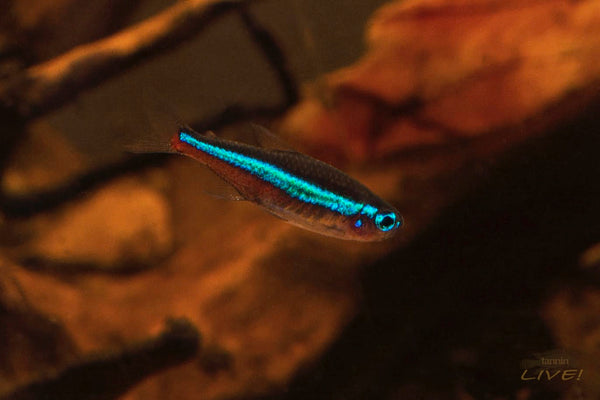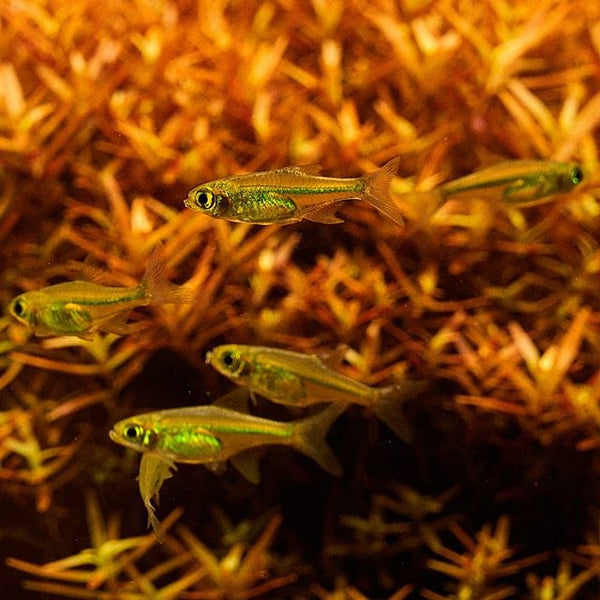- Continue Shopping
- Your Cart is Empty
Under the influence of botanicals...
Any discussion of lower pH and "tinted" water always seems to draw me back to that "archetype"of a blackwater system, the Rio Negro. Specifically, just how it became a "blackwater" system in the first place can give us some clues and ideas on managing our own captive blackwater, botanically-influenced systems.
And part of the game here is understanding what it is that makes this a blackwater river system to begin with. We often hear that blackwater is "low in nutrients."
What exactly does this mean?
One study concluded that the Rio Negro is a blackwater river in large part because the very low nutrient concentrations of the soils that drain into it have arisen as a result of "several cycles of weathering, erosion, and sedimentation." In other words, there's not a whole lot of minerals and nutrients left in the soils to dissolve into the water to any meaningful extent!

Perhaps...another reason (besides the previously cited limitation of light penetration) why aquatic plants are rather scare in these waters? It would appear that the bulk of the nutrients found in these blackwaters are likely dissolved into the aquatic environment by decomposing botanical materials, such as leaves, branches, etc.
Why does that sound familiar?

Besides the color, of course, the defining characteristics of blackwater rivers are pH values in the range of 4-5, low electrical conductivity, and minimal mineral content. Dissolved minerals, such as Ca, Mg, K, and Na are negligible. And with these low amounts of dissolved minerals come unique challenges for the animals who reside in these systems.

How do fishes survive and thrive in these rather extreme habitats?
It's long been known that fishes are well adapted to their natural habitats, particularly the more extreme ones. And this was borne out in a recent study of the Cardinal Tetra. Lab results suggest that humic substances protect cardinal tetras in the soft, acidic water in which they resides by preventing excessive sodium loss and stimulating calcium uptake to ensure proper homeostasis.
This is pretty extraordinary, as the humic substances found in the water actually enable the fishes to survive in this highly acidic water which is devoid of much mineral content typically needed for fishes to survive!
And of course, botanicals, leaves, and wood typically have an abundance of these humic substances, right? They are useful for more than just an interesting and unique aesthetic effect! There is a lot of room for research about influencing the overall environment in our aquariums here! I think we've barely scratched the surface of the potential for utilizing botanicals in our aquariums.

Now, lots of people ask about utilizing leaves and other botanicals to lower the pH in their aquariums. There seems to be a fair amount of misconception about what botanicals can and cannot do to your water in your aquarium. We field a fair number of questions asking stuff like "How many ____________ Pods do I need to lower the pH and hardness in my Betta tank?"
Ahhh. If only it were so simple!
Nature offers few "plug and play" solutions.
As you are no doubt aware by now from my rantings, many of these natural materials do release substances such as tannic and humic acids into the water, which can acidify it- IF the water has a low enough carbonate hardness (aka "KH"). Most botanicals won't do much to significantly reduce the pH if you start with hard, alkaline water, as the KH will prevent the acids released by these materials from reducing the pH.
In general, it's fairly safe (gulp) to state that soft water is usually acidic, and "hard" water is usually alkaline.
Oh, and the color of the water is no real indication of pH or hardness. 🤓
(Now, before we get too far, I'll dispense with the necessary disclosure that my knowledge of water chemistry is quite basic, and I'm not preferring that anything discussed here is even close to being the "last word" on the subject. It's an explanation of some facts and ideas based on my limited college chemistry and understanding of these things from being a practicing aquarist.
At a certain point in discussion about this stuff with really knowledgable people, my eyes start to glaze over...There are plenty of you out here who could "school me" on this stuff, and I encourage your input on these more esoteric, yet very important aspects of the hobby. We will all benefit.)
Ahh, back to that bit on carbonate hardness...
This is one of those terms, along with "general hardness" (GH), that we see bandied about all over the internet and in books and hobby discussions...It's super-confusing to me, as there are multiple ways of determining the hardness of water (in general, but for us it's for aquarium purposes). "Hardness", is essentially a measure of the total concentration of specific minerals dissolved in the water, including calcium and magnesium, as well as other minerals like potassium and sodium. It is said that the concentration of these minerals in a given quantity of water contribute to the "hardness."

There are a few ways of measuring this. As a reef hobbyist, I was long ago indoctrinated to utilize KH (from the german word "karbonate") to measure the carbonate and bicarbonate ions in a given aquatics system, which function as "buffers", and keep the pH from dropping.
And KH is a component of GH, to make matters more confusing (KH can never be higher than the "general hardness" of the water because of this fact). And a lot of test kits will measure both...as if a guy like myself needs more confusion in his life...

Bottom line: If you really want to create soft, acidic water, invest in a reverse osmosis/deionization unit. Then, your botanicals will have a lot more "play" in terms of how they can affect the pH in your aquarium. Botanicals alone will NOT affect KH. End of discussion.
Okay, the head-spinning part of this blog is over!
One of the things we've noted is that many aquarists are actually surprised by is just how little the pH is typically impacted by botanicals! Even with pure RO/DI water, like I use, and lots of wood and botanicals present, I've found that the pH in my tanks tends to find a range (within like .1 or .2, BTW) and stays there. In my instance, it's about 6.5-6.6. In fact, It's tough for me to get it much lower.

I think I have a hunch about why this is.
I think that the use of substrate materials, such as sand and rocks, may provide significant enough "buffering capacity" to keep the ph confined to a narrow range. Now, many of us have started experimenting with purely botanical substrates, creating a different and potentially more "aggressive" pH influence capacity...something we can come back to in the future!
Now, all that talk about low nutrients and dark water and such doesn't discourage me from making my big prediction for 2019:
2019 Is the year of the planted blackwater aquarium.
Yeah, it's painfully obvious that this is wide open for experimentation and breakthroughs. As we've discussed before, you might not see aquatic plants in areas like the Rio Negro region, but blackwater habitats worldwide do have a lot of aquatic plants growing in them. Think about Africa and Southeast Asia. Think about mosses, and plants like Cryptocoryne, Bucephalandra, Taxifolum, Nymphea, etc.

There are a LOT of different plants which come from blackwater habitats, and will thrive in such conditions in the aquarium. And I personally think that with the use of readily available nutrients, substrate enrichment, CO2 injection, and high intensity LED lighting, it's possible to keep a tremendous variety of plants in botanical-style, blackwater aquariums.
I'm not sure what was keeping this from becoming a "thing" in the hobby for a long time. Now, sure, hobbyists were experimenting with this from time to time, but not to any significant extent. I think that it was just a part of the whole "blackwater is dark and dirty and uncontrollable" mindset that existed in the hobby for years before- well, before we came along and tossed all of this stuff in your face every day!

Yeah, it's a mindset. A mental shift. A collective hesitation on the part of the planted aquarium community to step outside of the "comfort zone" to try something that seems "risky" or whatever.
I can't help but wonder if some of the advantages of botanicals in blackwater aquariums will spill over to aquatic plants. I am not aware of specific studies or research on tannin and humic substances and such in regards to the needs of aquatic plants, but I would imagine that many of the concepts of "substrate enrichment" that we play with for blackwater fish systems will have some benefit for planted systems as well.

And the light penetration issue is, IMHO, not really much of an issue anymore, IMHO. We have perfectly capable high intensity LED lighting which can be adjusted and customized for a variety of situations. Sure, in the wild, light penetration into blackwater habitats does indeed limit plant growth. However, in the cozy confines of the aquarium, it's entirely possible to get a lot of plants to thrive! It's not much different from the work we've done for years propagating corals, compensating various parameters to offset any possible detriments.

In other words, there is a lot of good experimentation and work to be done here! I think we are going to see more and more beautiful and "functionally aesthetic" aquascapes with aquatic plants and botanicals showing up worldwide. The opportunity to create compelling, highly unique, and utterly successful planted aquariums in this realm is ripe for breakthroughs!
So, it's really all about understanding what exactly botanicals can do in the context of impacting water chemistry, and what types of parameters we want to provide our fishes and animals in our tanks. And of course, what kinds of aesthetics and effects we are trying to achieve. We can be as experimental or realistic as we'd like. It's all about getting out there and DOING.

So, when we contemplate the influence of botanicals and their impact on water chemistry and our ability to grow aquatic plants, spawn touchy fishes, and rear fry, there is so much to work with! Having a basic working knowledge about water chemistry in the blackwater aquarium can help us conduct some interesting and productive experiments in this ever-expanding area of the aquarium hobby!
Stay informed. Stay excited. Stay experimental. Stay educated. Stay open-minded...
And Stay Wet.
Scott Fellman
Tannin Aquatics









Scott Fellman
Author